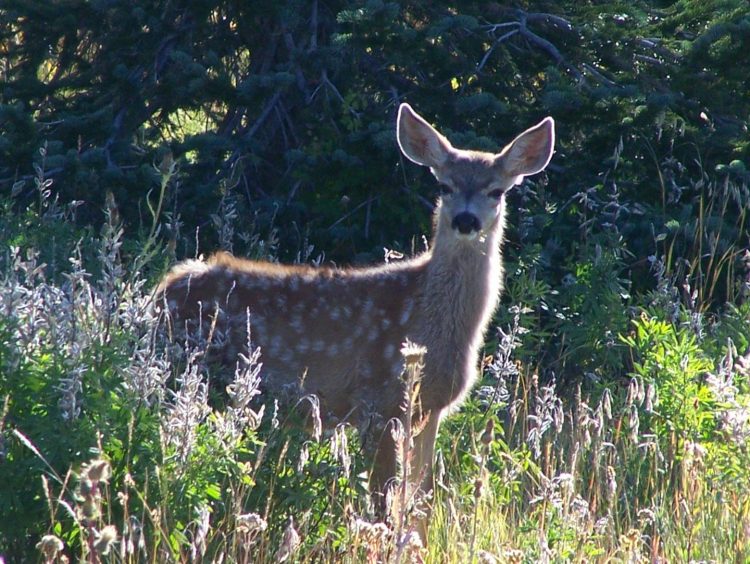Tracking deer by NASA satellite

A mule deer fawn emerges from the foliage in this National Park Service photo. Credits: US National Park Service
Raising a fawn is no easy task – a doe needs a rich supply of vegetation for the late stages of pregnancy and for nursing. Mule deer birth rates peak shortly before the peak of annual plant growth, when food sources are increasing. Through a combination of satellite measurements and ground-based population counts, researchers can forecast the timing of fawning seasons based on vegetation.
“We had never tracked the deer population this way, and we had never been able to predict it with such precision,” said David Stoner of Utah State University, lead author of a recent study. “We can estimate the start and peak of the season using satellite imagery, and then we can map and predict when the deer are giving birth in any given region.”
Mule deer populations are closely monitored and counted by biologists and land managers, in part to determine population trends over time, which helps them set the proper number of hunting permits to issue. At the same time, remote sensing scientists have a space-based way to track when vegetation greens up and how productive it is compared to drought or wet years. the health of vegetation
. The tool is called the Normalized Difference Vegetation Index (NDVI), which is a measure of the “greenness” of the landscape. It measures how plants absorb and reflect light — the more infrared light is reflected, the healthier the vegetation. So by measuring the greenness of the mule deer habitat, scientists were able to mark the beginning and peak of the plant growing season – and the fawning season.
To visualize the relationship between vegetation greenness and fawns, Stoner and his colleagues divided mule deer habitat that stretched from southern Idaho to central Arizona into three zones. They measured the NDVI for each day of the calendar year, using the Moderate Resolution Imaging Spectroradiometer (MODIS) instruments on NASA's Terra and Aqua satellites.
They found that vegetation greenness in the northern latitudes peaks earlier than in the southern latitudes, according to Stoner. Since nutrient-dense food sources were available earlier in the year, there was more food available for mule deer mothers and babies at the time when they needed it most. That greenness is partly a result of a consistent stream of snowmelt moisture feeding the deep roots of mountain plants.
In southern latitudes, on the other hand, the plants are more dependent on rain from late summer monsoonal showers. This means vegetation quality peaks later in the year, after a brief drought that comes before the summer monsoons. As a result, does give birth later in the south than in the north.
“This kind of applied research is very important for making remote sensing data relevant to wildlife management efforts,” said Jyoteshwar Nagol, a researcher at the University of Maryland. Deer have a huge economic impact in the United States, from hunting to crop damage to car accidents. As regional climates shift or droughts occur, deer distributions could change in response to changes in the timing of vegetation green-up.
###
For more information:
Earth Observatory Story:
http://earthobservatory.
Media Contact
All latest news from the category: Earth Sciences
Earth Sciences (also referred to as Geosciences), which deals with basic issues surrounding our planet, plays a vital role in the area of energy and raw materials supply.
Earth Sciences comprises subjects such as geology, geography, geological informatics, paleontology, mineralogy, petrography, crystallography, geophysics, geodesy, glaciology, cartography, photogrammetry, meteorology and seismology, early-warning systems, earthquake research and polar research.
Newest articles

Properties of new materials for microchips
… can now be measured well. Reseachers of Delft University of Technology demonstrated measuring performance properties of ultrathin silicon membranes. Making ever smaller and more powerful chips requires new ultrathin…

Floating solar’s potential
… to support sustainable development by addressing climate, water, and energy goals holistically. A new study published this week in Nature Energy raises the potential for floating solar photovoltaics (FPV)…

Skyrmions move at record speeds
… a step towards the computing of the future. An international research team led by scientists from the CNRS1 has discovered that the magnetic nanobubbles2 known as skyrmions can be…




















